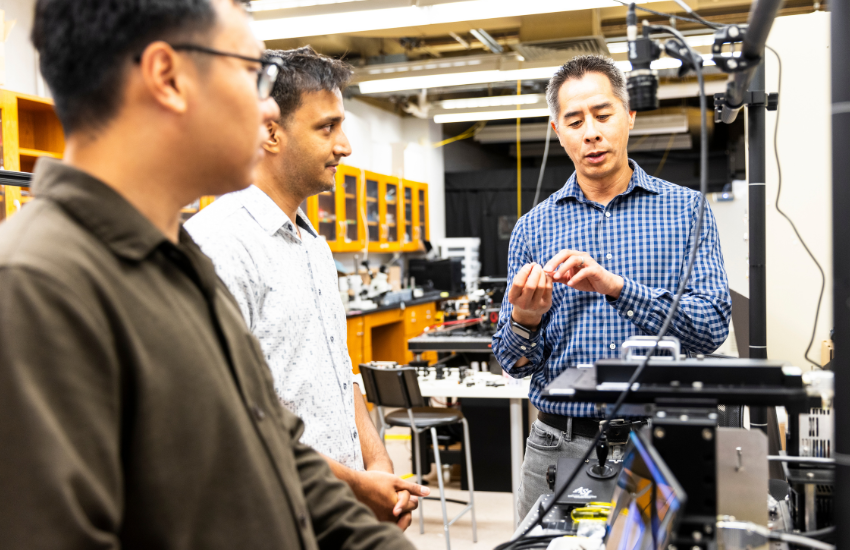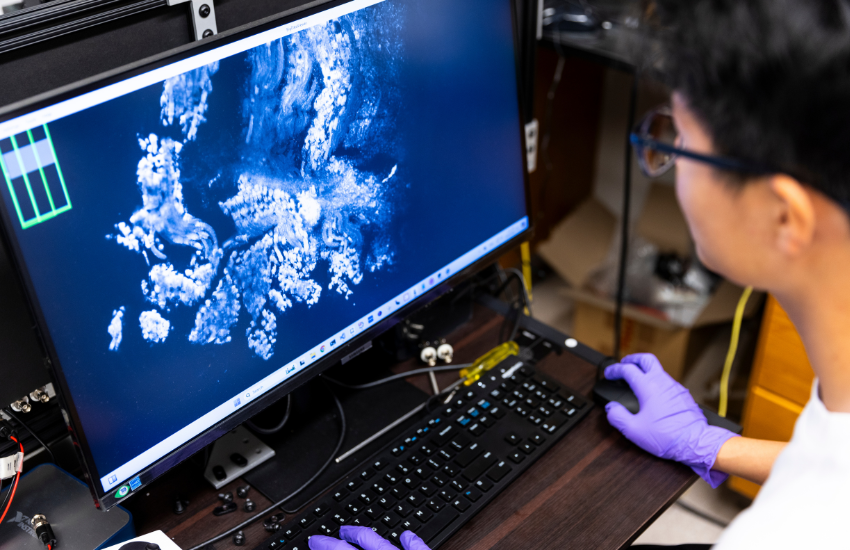Story by Lyra Fontaine, photos by Dennis Wise/UW Photo
August 13, 2024
A new Advanced Research Projects Agency for Health (ARPA-H) project aims to build on and test technologies developed in ME Professor Jonathan Liu’s lab to help surgeons remove tumors more precisely and efficiently.

ME Professor Jonathan Liu will lead a new multi-university project that aims to help surgeons to remove tumors more completely and rapidly during a single procedure. From left-right: graduate student Rui Wang, research engineer Rauf Kareem and Liu.
Almost 2 million new cancer cases are diagnosed in the U.S. every year, and surgical removal is often the first treatment option for solid tumors. However, it’s difficult for surgeons to identify the surgical margin, which is the edge of healthy tissue surrounding the tumor, during surgery. If cancer remains present at the margin after the procedure, studies show that their long-term outcomes are generally worse. Patients may also need to undergo additional costly and risky treatments, including additional surgeries to remove the residual tumor.

ME Professor Jonathan Liu will lead a new multi-university project that aims to help surgeons to remove tumors more completely and rapidly during a single procedure.
A new multi-university project led by Liu aims to help surgeons to remove cancer tumors more completely and rapidly during a single procedure. The academic-industry partnership, which includes a collaboration with Alpenglow Biosciences Inc., Harvard Medical School and large-scale clinical studies at UW Medicine and Vanderbilt University Medical Center, is funded by an up to $21.1 million award from ARPA-H.
Building on the technologies developed in Liu’s lab, the goal is to develop an intraoperative “flatbed scanner,” which would be located in the operating room and used to comprehensively image the margin surfaces of surgical specimens within 15 minutes of their removal. The images will assist surgeons in determining whether the entire tumor was removed, and if not, where they should continue to resect.
I’m excited about the potential to develop and refine a technology to the point where it can potentially be commercialized and have a real-world impact for surgeons and patients with cancer.”
“Developing these technologies, which include imaging hardware and AI analysis methods, and validating them well in the clinic requires a large team of investigators, which is difficult to fund with other funding mechanisms,” Liu says. “ARPA-H provides the vision, resources and funding to make this type of research possible.”
ARPA-H was established in 2022 within the U.S. Department of Health and Human Services to improve the U.S. government’s ability to accelerate high-potential, high-impact biomedical and health solutions. The funding agency invests in projects that cannot be easily achieved with standard funding mechanisms, with the aim of leveraging research advances for real-world impact, which aligns with Liu’s goals.
“We need to develop and validate our methods within realistic surgical environments in collaboration with a team of clinicians at various sites working on different forms of cancer,” Liu says. “I’m excited about the potential to develop and refine a technology to the point where it can potentially be commercialized and have a real-world impact for surgeons and patients with cancer.”
Developing tech to guide surgeons
Preliminary studies have shown that the open-top light-sheet (OTLS) microscopy technologies developed by Liu’s lab can, in principle, allow for rapid microscopic imaging of fresh tissue surfaces to guide tumor-resection procedures. Unlike the currently used 2D method for assessing the margin, OTLS can provide a 3D view of the margin surfaces, which could lead to more complete tumor resection and better patient outcomes. The non-destructive approach doesn’t require manual tissue preparation and could reduce costs.
However, before it can be useful for surgeons, the technology must be able to image very large specimens at the cellular scale within a short enough time window. These ARPA-H studies are the first time that the 3D imaging and AI technologies developed by Liu’s lab will be tested under realistic surgical conditions. The funding also enables the researchers to improve their technologies with the level of automation, speed and accuracy needed for clinical adoption.
Since spatial resolution or magnification trades off severely with imaging speed, the researchers will image the majority of the surgical margin at relatively low resolution and rely on AI algorithms to identify the riskiest “hotspots” to selectively image at higher resolution for accurate diagnosis of residual tumor cells at the margin surfaces. Liu’s team will develop multi-resolution AI analysis methods in collaboration with Faisal Mahmood, associate professor of pathology at the Brigham and Women’s Hospital of Harvard Medical School.

Graduate student Qinghua Han examines images of surgical margin surfaces provided by open-top light-sheet microscopy (OTLS) technologies. After a rapid low-resolution scan of the specimen surface (surgical margin), AI algorithms will identify the riskiest “hotspots” to selectively image at higher resolution to enable definitive diagnosis.
The research aims to improve surgical guidance for breast cancer and head and neck cancer. At UW Medicine, studies will focus on breast lumpectomy procedures for clinical validation, led by Dr. Sara Javid, professor of surgery at the UW School of Medicine, and Dr. Suzanne Dintzis, professor in laboratory medicine and pathology at the UW School of Medicine. Surgeons at Vanderbilt, Dr. Eben Rosenthal and Dr. Michael Topf, will lead studies focusing on head and neck surgical specimens. In addition, the project will fund the first research collaboration between Liu and a company he co-founded in 2018, Alpenglow Biosciences Inc. Dr. Nicholas Reder, a clinical instructor at the UW Medicine Department of Laboratory Medicine & Pathology and CEO of Alpenglow, was formerly a pathology resident at the UW as well as a researcher in Liu’s lab.
U.S. Senator Patty Murray weighed in on the news of the UW's ARPA-H award:
"The cutting-edge work happening at UW will help doctors get a full, accurate picture of the tumors they are working to treat, so they can make sure patients get the most effective care possible."
— U.S. Senator Patty Murray
View more information in the ARPA-H press release. For more information on Precision Surgical Interventions, visit the PSI program page.